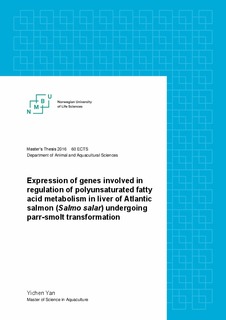| dc.description.abstract | Purposes
The primary aim of this thesis was to study if differences in nutritional and environmental factors influence the regulation of n-3 LC-PUFA synthesis in liver of Atlantic salmon (big smolts) undergoing parr-smolt transformation.
A further aim was to use the cell line RTH-149 to establish a protocol for gene knockout of ∆6 desaturase isoform ∆6fad_b.
Methods
The experimental fish were fed a commercial diet until the start of the trial (30 October 2012), and thereafter fed a diet with an oil fraction consisting of only 10% fish oil (FO) and 90% vegetable oil (VO) until the end of the trial. The fish were kept under full light (24 hours per day), except in a period from 20 November 2012 to 16 January 2013, when the light duration was gradually reduced from 24 hours to 12 hours in order to delay the smoltification process in the fish so that a large smolt could be produced in freshwater. Thereafter the fish were subjected to 24 hours light again to prepare it for final smoltification and transfer to seawater in February at approximately 400 gram. The expression of the selected genes (including ∆5 and ∆6 desaturases, transcription factors PPARα and SREBPS, and microRNAs which are related to lipid metabolism) was determined at four time points (30 October 2012, 27 November 2012, 26 February 2013 and 12 March 2013) during this fish trial.
Cell line RTH-149 were transfected at a confluence of approximately 70% by CRISPR-Cas9 system with either sgRNA1, sgRNA2, sgRNA1/2 (a combination of sgRNA1 and sgRNA2, both sgRNA1 and sgRNA2 are targeting gene ∆6fad_b but with different cleavage sites) or sgRNA of control random-oligo. The differently transfected cells were further split for time-course study. The expression of the protein coding genes was determined at three selected time points during a 24-hour experiment with an interval of eight hours (i.e. at 8:00, 16:00 and 0:00).
Results
The expression of ∆5fad and ∆6fad_a increased slightly up to the seawater transfer, and then decreased after seawater transfer. The expressions of these genes in March were almost returned to their starting levels of expression in October. On the contrary, the expression of ∆6fad_b and ∆6fad_c showed a similar pattern of expression from October to February, but the opposite pattern to ∆5fad and ∆6fad_a with an increased expression after seawater transfer. The expression of the transcription factors pparα, srebp-1 and srebp-2 dropped from October to February and thereafter increased prior to seawater transfer, after which the expression levels of pparα and srebp-1 again significantly decreased after seawater transfer except srebp-2 which did not change in seawater. The expressions of mir-122-5p dropped from October to November; the expression increased prior to seawater transfer and thereafter dropped again in seawater. The gene expression of mir-30c-3p, mir-8163-3p, mir-27a-3p, mir-15a-5p, mir-429-3p, mir-33a-3p and mir-145-3p showed a similar pattern prior to seawater transfer, but the expression did not change after transfer to seawater.
There were reduced expression levels of ∆6fad_b 24 hours after transfection but together with a restrained growth rate and a low viability of the cell cultures. There were relatively moderate and few significant differences in the expression of genes involved in lipid metabolism between the three time points measured during the 24 hour duration of experiment in the RTH cell line. Further, we disclosed a potential positive relationship between ∆6fad_a, ∆6fad_b, elovl2a, elovl2b, elovl5a and aco, and a potential compensatory response of gene ∆5fad to the silencing of gene ∆6fad_b.
Conclusions
This present study has shown that both nutritional and environmental factors influence expression of genes involved in regulation of LC-PUFA in liver of Atlantic salmon undergoing parr-smolt transformation. This is the first time that transcription factors and microRNAs were involved in a dynamic regulation of the omega-3 metabolic pathway under different environmental conditions at different life stages. | nb_NO |
